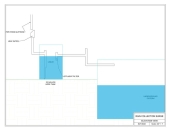
 1
1




 1
1








Glenn Herbert wrote:It sounds like you operate your valves manually? I thought first flush systems had some sort of automatic setup so the first X gallons go to flush, then the rest goes to storage. If you are always home to do the switching, I suppose it can work.
Glenn Herbert wrote:Without experience in first flush diverters, I would think to have something where the flush branch goes down a tiny bit and the storage branch goes up, just enough to positively send debris to the flush branch. Then they would both slope to their destinations. I would think the flush branch would want to be normally open, so an unexpected rain wouldn't send dirty water to storage. If that is the case, and the branches are oriented as I described, you would probably not need a valve on the storage branch. With a slightly leaky valve on the flush branch, any trapped water would drain away eventually so as not to have standing water.
Glenn Herbert wrote:You would really want some sort of control on the valve that would automatically open it when water stops flowing, rather than have to remember to switch it after every rain.
 2
2




![Filename: FirstFlush.gif
Description: [Thumbnail for FirstFlush.gif]](/t/71307/a/55057/FirstFlush.gif)
affiliate links
Building a Cob Style Rocket Mass Heater




 1
1




 1
1




 2
2




My opinions are barely worth the paper they are written on here, but hopefully they can spark some new ideas, or at least a different train of thought




 1
1




![Filename: img_0675-350w.jpg
Description: Small standpipe system full view [Thumbnail for img_0675-350w.jpg]](/t/71307/a/55151/img_0675-350w.jpg)
![Filename: img_0676-200w.jpg
Description: Small standpipe base & cleanout detail [Thumbnail for img_0676-200w.jpg]](/t/71307/a/55152/img_0676-200w.jpg)
--
John Schinnerer, MA Whole Systems Design
Eco-Living Whole Systems Design services
 1
1








Due to Exponential Demography (from 2.5 to 7.5 billions poeple in my life time) this planet is dying








John Schinnerer wrote:The no moving parts standpipe first flush design is a highly preferred solution. Keep it simple, and then make it simpler.
This is in the Texas Guide to Rainwater Harvesting, pp. 8-9 have relevant text and diagrams:
http://www.twdb.texas.gov/publications/brochures/conservation/doc/RainwaterHarvestingManual_3rdedition.pdf
It's been in the TGRH since the first edition from probably a couple decades back at least, and copied into most books/articles since then with minor modifications (some of them devolutionary, see further below).
I thought everyone in permie-land knew about this reference by now but apparently not. Spread the word. It's free!
Note the information on rainfall intensity needed to actually move material off a roof; also the recommended diversion amount (1-2 gal per 100 sq. ft. roof). The 3rd edition even gives you gal. capacity per length for various standpipe sizes, but do the math anyway, it's good for your neural network health!
This is basically the same as the standpipe diagram posted above. But it's easier structurally if you let the standpipe stand on its own base and have the ground support the weight of the water (especially for large capacity standpipes) rather than hanging in the air. I use a wye cleanout at the bottom and set it on stone or drain gravel. If you hang the standpipe (which is then a hangpipe) on the structure, you have to support the weight of it full of water with brackets and what not - less simple, more work & materials.




John Walsh wrote:
I'm not a expert or anything but the fine dust ending up in the bottom of your tank is probably just tree pollen and crap like that, not horrible. Every tank has biosludge in the bottom eventually and in fact I think it helps keep the water clean. The trick is not to disturb it.




Jean Pierre Michotte wrote:This seems to me a lot of work for nothing. Graf is selling filter for their rain collector They ae working fine for me since the installation 3 years ago.
http://www.graf-water.com/rainwater-harvesting/filter.html
The germans are very good engineers : just buy the right thing or write them an email for help
Jean Pierre





|
It's exactly the same and completely different as this tiny ad:
Homestead Pigs Course
https://permies.com/wiki/365748/Homestead-Pigs
|




